MEXICO CITY (AP) — President Claudia Sheinbaum suggested Tuesday that Mexico could retaliate with tariffs of its own, after U.S. President-elect Donald Trump threatened to impose 25% import duties on Mexican goods if the country doesn’t stop the flow of drugs and migrants across the border.
Sheinbaum said she was willing to engage in talks on the issues, but said drugs were a U.S. problem.
“One tariff would be followed by another in response, and so on until we put at risk common businesses,” Sheinbaum said, referring to U.S. automakers that have plants on both sides of the border.
She said Tuesday that Mexico had done a lot to stem the flow of migrants, noting “caravans of migrants no longer reach the border.” However, Mexico's efforts to fight drugs like the deadly synthetic opioid fentanyl — which is manufactured by Mexican cartels using chemicals imported from China — have weakened in the last year.
Sheinbaum said Mexico suffered from an influx of weapons smuggled in from the United States, and said the flow of drugs “is a problem of public health and consumption in your country’s society.”
Sheinbaum also criticized U.S. spending on weapons, saying the money should instead be spent regionally to address the problem of migration. “If a percentage of what the United States spends on war were dedicated to peace and development, that would address the underlying causes of migration,” she said.
Sheinbaum’s bristly response suggests that Trump faces a much different Mexican president than he did in his first term.
Back in late 2018, former President Andrés Manuel López Obrador was a charismatic, old-school politician who developed a chummy relationship with Trump. The two were eventually able to strike a bargain in which Mexico helped keep migrants away from the border — and received other countries’ deported migrants — and Trump backed down on the threats.
But Sheinbaum, who took office Oct. 1, is a stern leftist ideologue trained in radical student protest movements, and appears less willing to pacify or mollify Trump.
“We negotiate as equals, there is no subordination here, because we are a great nation,” Sheinbaum said, while adding, “I think we are going to reach an agreement.”
But Gabriela Siller, director of economic analysis of the financial group Banco Base, fears the personality clash could escalate things into brinkmanship; Trump clearly hates to lose.
“Trump may have just tossed the threat out there, as he does,” Siller said. “But Mexico's response, that we're going to respond to you with tariffs, that will make Trump really impose them.”
It's not clear how serious Trump’s threat is. The U.S.-Mexico-Canada free trade agreement forbids just imposing tariffs on other member countries. And it’s not clear whether the economy could even tolerate sudden levies on imports: Auto plants on both sides of the border rely on each other for parts and components, and some production lines could screech to a halt.
“It is unacceptable and would cause inflation and job losses in Mexico and the United States,” Sheinbaum said, while offering to talk about the issues. “If tariffs go up, who will it hurt? General Motors,” she said.
“Dialogue is the best path to achieve understanding, peace and prosperity for our two countries,” Sheinbaum said. “I hope our teams can meet soon.”
Late Monday, Trump said he would impose a 25% tax on all products entering the country from Canada and Mexico, and an additional 10% tariff on goods from China, as one of his first executive orders.
The tariffs, if implemented, could dramatically raise prices for American consumers on everything from gas to automobiles to agricultural products. The U.S. is the largest importer of goods in the world, with Mexico, China and Canada its top three suppliers, according to the most recent U.S. Census data.
Trump made the threats Monday in a pair of posts on his Truth Social site in which he railed against an influx of illegal migrants, even though apprehensions at the southern border have been hovering near four-year lows.
“On January 20th, as one of my many first Executive Orders, I will sign all necessary documents to charge Mexico and Canada a 25% Tariff on ALL products coming into the United States, and its ridiculous Open Borders,” he wrote.
He said the new tariffs would remain in place “until such time as Drugs, in particular Fentanyl, and all Illegal Aliens stop this Invasion of our Country!”
“Both Mexico and Canada have the absolute right and power to easily solve this long simmering problem. We hereby demand that they use this power,” he went on, “and until such time that they do, it is time for them to pay a very big price!”

FILE - Newly-sworn in President Claudia Sheinbaum addresses supporters in the Zócalo, Mexico City's main square, on Oct. 1, 2024. (AP Photo/Fernando Llano, File)
NEW YORK (AP) — U.S. stocks are hanging near their records on Tuesday as Wall Street takes Donald Trump’slatest talk about tariffs in stride, even if they could roil the global economy were they to take effect.
The S&P 500 rose 0.3% in morning trading and was on track to squeak past its all-time high set a couple weeks ago. The Dow Jones Industrial Average lost 270 points, or 0.6%, from its own record set the day before, while the Nasdaq composite was 0.6% higher, as of 10:45 a.m. Eastern time.
Stock markets abroad were down, but mostly only modestly, after President-elect Trump said he plans to impose sweeping new tariffs on Mexico, Canada and China as soon as he takes office. Stock indexes were down 0.1% in Shanghai and nearly flat in Hong Kong, while Canada's main index was down 0.4%.
Trump has often praised the use of tariffs, but investors are weighing whether his latest threat will actually become policy or is just an opening point for negotiations. For now, the market seems to be taking it more as the latter.
Unless the United States can prepare alternatives for the autos, energy products and other goods that come from Mexico, Canada and China, such tariffs would raise the price of imported items all at once and make households poorer, according to Carl Weinberg and Rubeela Farooqi, economists at High Frequency Economics. They would also hurt profit margins for U.S. companies, while raising the threat of retaliatory tariffs by other countries.
General Motors sank 7.3%, and Ford Motor fell 1.8%. Constellation Brands, which sells Modelo and other Mexican beers in the United States, dropped 4.4%.
Beyond the pain such tariffs would cause U.S. households and businesses, they could also push the Federal Reserve to slow or even halt its cuts to interest rates. The Fed had just begun cutting its main interest rate from a two-decade high a couple months ago to offer support to the job market. While lower interest rates can boost the overall economy and prices for investments, they can also offer more fuel for inflation.
Unlike tariffs in Trump's first term, his proposal from Monday night would affect products across the board.
Trump’s tariff talk came almost immediately after U.S. stocks rose Monday amid excitement about his pick for Treasury secretary, Scott Bessent. The hope was the hedge-fund manager could steer Trump away from policies that balloon the U.S. government deficit, which is how much more it spends than it takes in through taxes and other revenue.
The talk about tariffs overshadowed another set of mixed profit reports from U.S. retailers that answered few questions about how much more shoppers can keep spending. They’ll need to stay resilient after helping the economy avoid a recession, despite the high interest rates instituted by the Fed to get inflation under control.
Kohl’s tumbled 20.4% after its results for the latest quarter fell short of analysts’ expectations. CEO Tom Kingsbury said sales remain soft for apparel and footwear, which helped drag its revenue lower. Kingsbury said a day earlier that he plans to step down as CEO in January. Ashley Buchanan, CEO of Michaels and a retail veteran, will replace him.
Best Buy fell 8% after likewise falling short of analysts’ expectations. Dick’s Sporting Goods topped forecasts for the latest quarter thanks to a strong back-to-school season, but its stock lost an early gain to fall 2.4%.
A report on Tuesday from the Conference Board said confidence among U.S. consumers improved in November, but not by as much as economists expected.
J.M. Smucker jumped 7.6% for one of the biggest gains in the S&P 500 after topping analysts' expectations for the latest quarter. CEO Mark Smucker credited strength for its Uncrustables, Meow Mix, Café Bustelo and Jif brands.
Big Tech stocks also helped prop up U.S. indexes. Gains of 2.7% for Amazon and 1.9% for Microsoft were two of the strongest forces lifting the S&P 500.
In the bond market, Treasury yields rose following their big drop from a day before driven by relief following Trump’s pick for Treasury secretary.
The yield on the 10-year Treasury climbed to 4.31% from 4.28% late Monday, but it’s still well below the 4.41% level where it ended last week.
In the crypto market, bitcoin continued to pull back after topping $99,000 for the first time late last week. It's since dipped back toward $93,400, according to CoinDesk.
It’s a sharp turnaround from the bonanza that had earlier taken over the crypto market following Trump’s election. That boom had also appeared to have spilled over into some corners of the stock market. Strategists at Barclays Capital pointed to stocks of unprofitable companies, along with other areas that can be caught up in bursts of optimism by smaller-pocketed “retail” investors.
AP Business Writer Elaine Kurtenbach contributed.
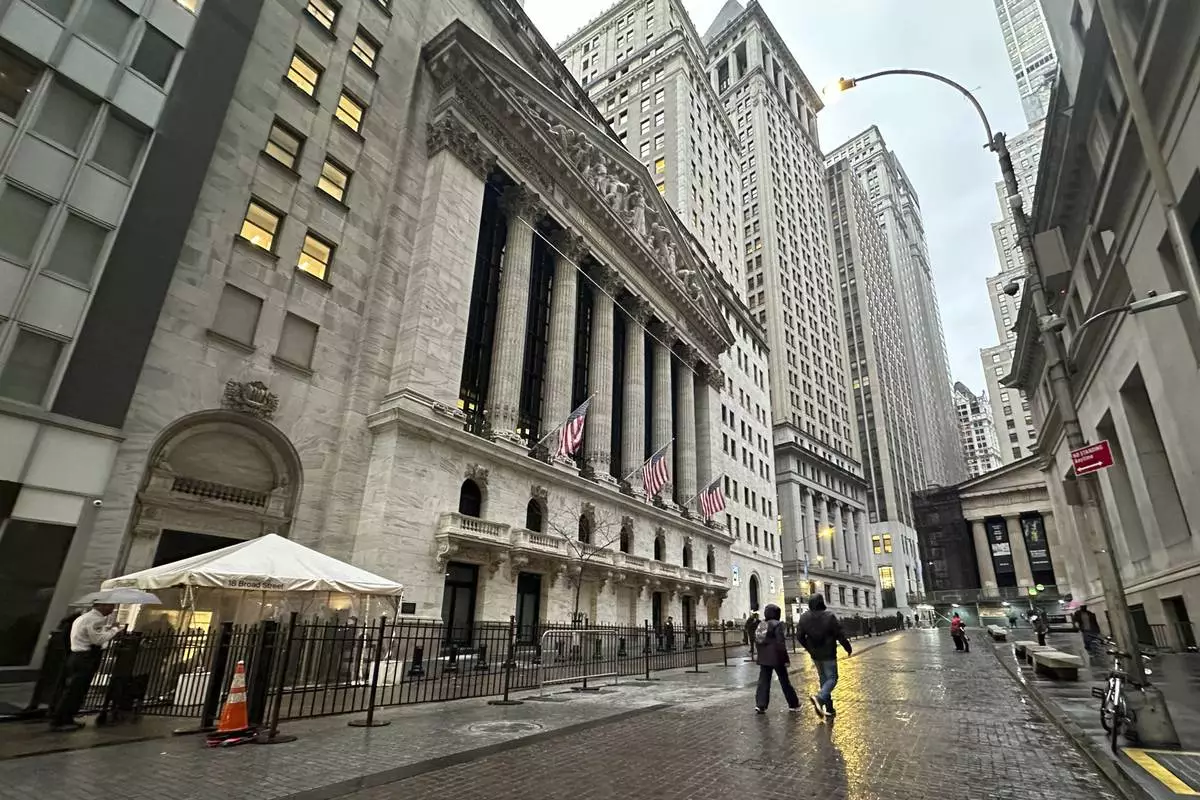
People walk past the New York Stock Exchange on Tuesday, Nov. 26 2024. (AP Photo/Peter Morgan)
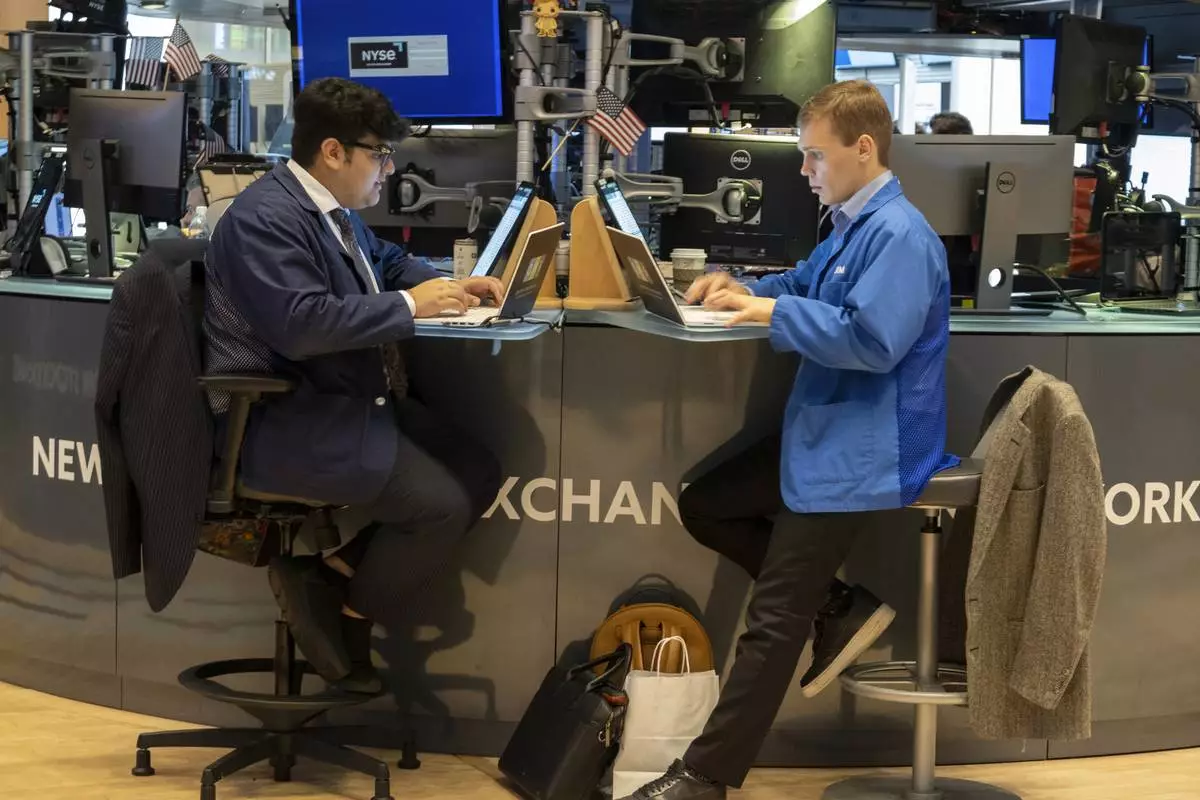
FILE - People work on the New York Stock Exchange trading floor in New York on November 21, 2024. (AP Photo/Ted Shaffrey, File)

People walk in front of an electronic stock board showing Japan's Nikkei index at a securities firm Tuesday, Nov. 26, 2024, in Tokyo. (AP Photo/Eugene Hoshiko)

People walk in front of an electronic stock board showing Japan's Nikkei index at a securities firm Tuesday, Nov. 26, 2024, in Tokyo. (AP Photo/Eugene Hoshiko)

A person walks in front of the Tokyo Stock Exchange building at a securities firm Tuesday, Nov. 26, 2024, in Tokyo. (AP Photo/Eugene Hoshiko)
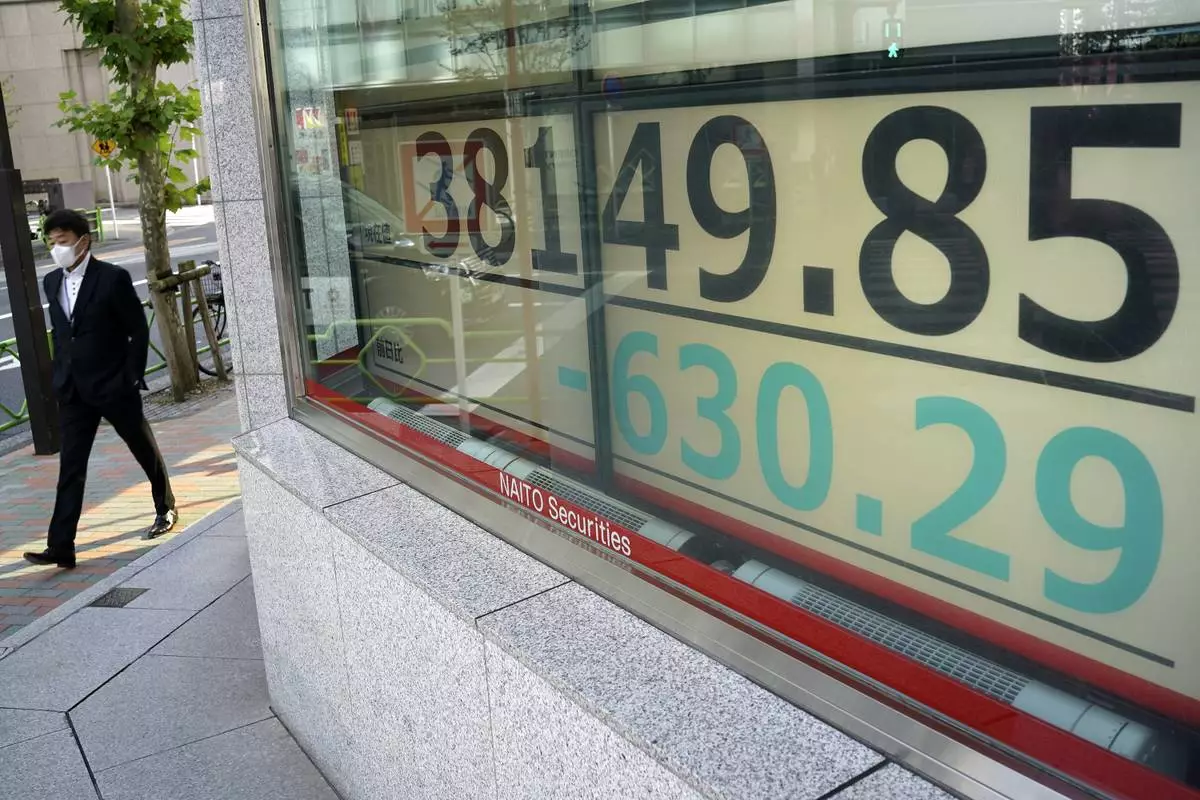
A person walks in front of an electronic stock board showing Japan's Nikkei index at a securities firm Tuesday, Nov. 26, 2024, in Tokyo. (AP Photo/Eugene Hoshiko)
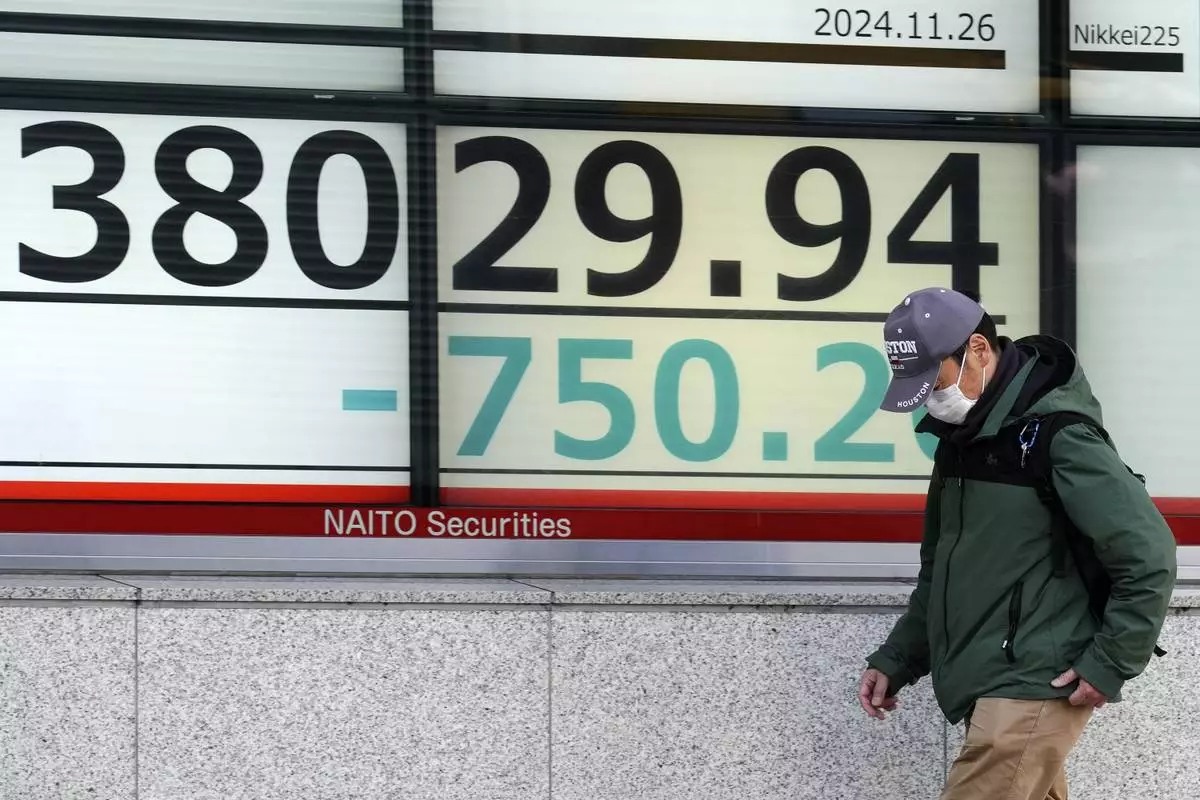
A person walks in front of an electronic stock board showing Japan's Nikkei index at a securities firm Tuesday, Nov. 26, 2024, in Tokyo. (AP Photo/Eugene Hoshiko)
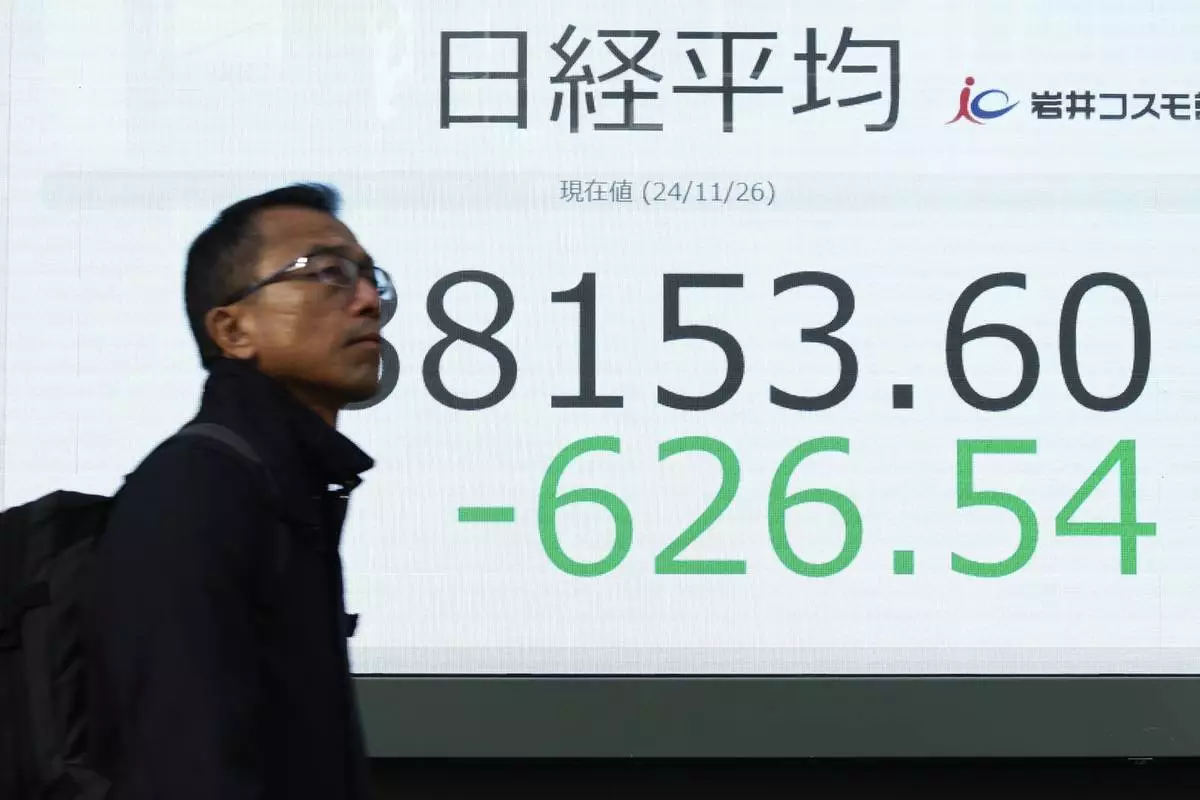
A person walks in front of an electronic stock board showing part of Japan's Nikkei index at a securities firm Tuesday, Nov. 26, 2024, in Tokyo. (AP Photo/Eugene Hoshiko)


















